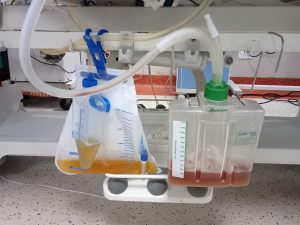Chest drains are mainly used in cardiac and thoracic surgery. The chest drain is applied for the collection of fluids from the fluids. The tubes are made of heavy Silastic or polyvinyl chloride products. Chest tube Insertion procedure is done in the emergency condition and in post-operative thoracotomy using a chest tube drainage system
Chest Tube Indication
closed-chest drain
Thoracotomy
Pleural effusion and pneumothorax.
Assess the chest tube and water seal chamber for the presence of fluctuation
Chest x-ray to ensure proper placement of the catheter
Milk the chest tube every hour before recording the amount drained and 2 hourly once the drainage stops.
Verify the appropriate amount of suction to be applied to the drainage system to remove air or blood more effectively
Assess the amount of drainage
Requirement of Chest Tube insertion
200 ml/hour of blood draining indicates a bleeding problem. Any drainage >100ml/hr
should be informed to the doctor.
Change dressing daily
Clamp the chest tube to prevent air from entering the pleural space and change the drainage bottle.
At no time the drainage bottle lifts it above the level of the patient body. Drainage bottle needs to change every 24 hours. Do not clamp chest. the tube in case of pneumothorax and if active air leak. Equipment for removal of the drainage tube.
- Gloves
- Betadine
- Clean up swabs
- # 11 BP blade
- Clamp
- Plastic cover to protect the bed
- Micropore.
Explain the procedure to the patient – 2 persons are needed – one to tie the suture and one
to remove the tube
X-ray the chest after removal of a chest tube
Observe for subcutaneous emphysema.
Chest tube Insertion Procedure
The tube inserted to the lateral of the chest by making a small incision in between the intercostal rings to reach the pleural cavity. Once it is reached the pleural cavity, the tube is connected to the under the water-seal drainage to remove the air, fluids from the thoracic cavity and pericardial cavity from the bronchus.
Assess the tube and the water seal chamber for the presence of fluctuation.
After the insertion, the chest drain tube fixed with the Non-absorbable suture and dressing must be done with petroleum gauze or plain sterile gauze covering the tube insertion site.
Continuous monitoring of the under water-seal chest drain collection with the leveled water.
Complication
Pneumothorax.
Infection.